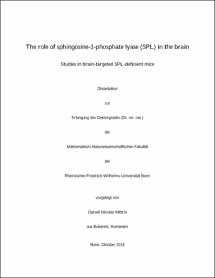Mitroi, Daniel Nicolae: The role of sphingosine-1-phosphate lyase (SPL) in the brain : Studies in brain-targeted SPL-deficient mice. - Bonn, 2017. - Dissertation, Rheinische Friedrich-Wilhelms-Universität Bonn.
Online-Ausgabe in bonndoc: https://nbn-resolving.org/urn:nbn:de:hbz:5n-46515
Online-Ausgabe in bonndoc: https://nbn-resolving.org/urn:nbn:de:hbz:5n-46515
@phdthesis{handle:20.500.11811/7136,
urn: https://nbn-resolving.org/urn:nbn:de:hbz:5n-46515,
author = {{Daniel Nicolae Mitroi}},
title = {The role of sphingosine-1-phosphate lyase (SPL) in the brain : Studies in brain-targeted SPL-deficient mice},
school = {Rheinische Friedrich-Wilhelms-Universität Bonn},
year = 2017,
month = may,
note = {The bioactive lipid sphingosine 1-phosphate (S1P) is a degradation product of sphingolipids that are particularly abundant in neurons. It was shown previously that neuronal S1P accumulation is toxic leading to ER-stress and an increase in intracellular calcium. To clarify the neuronal function of S1P, a brain-specific knockout mouse model was generated, in which S1P-lyase (SPL), the enzyme responsible for irreversible S1P cleavage was inactivated (SPLfl/fl/Nes mice).
SPL cleaves S1P into ethanolamine phosphate, which is directed towards the synthesis of phosphatidylethanolamine (PE) that is an anchor to autophagosomes for LC3-I. In the brains of SPLfl/fl/Nes mic significantly reduced PE levels were detected. Accordingly, autophagy alterations involving decreased conversion of LC3-I to LC3-II and increased beclin-1 and p62 levels were apparent. Alterations were also noticed in downstream events of the autophagic-lysosomal pathway like increased levels of lysosomal markers and aggregate prone proteins such as amyloid precursor protein, α-synuclein and tau protein. Genetic and pharmacological inhibition of SPL in cultured neurons promoted these alterations while addition of PE was sufficient to restore LC3-I to LC3-II conversion, and control levels of p62, APP and α-synuclein. Rapamycin, which is an agonist of autophagy by inhibition of mTOR kinase, had no effect on autophagy in neuronal cultures from SPLfl/fl/Nes mice suggesting that the impaired autophagy seen in SPLfl/fl/Nes mice is mTOR independent. Electron and immunofluorescence microscopy showed accumulation of unclosed phagophore-like structures, reduction of autophagolysosomes and altered distribution of LC3 in SPLfl/fl/Nes brains. Experiments using mRFP-EGFP-LC3 provided further support for blockage of the autophagic flux at initiation stages upon SPL deficiency due to PE paucity.
Developmental ablation of SPL in the brain (SPLfl/fl/Nes) caused marked accumulation of S1P and sphingosine. These changes in lipid composition lead to morphological, molecular and behavioral abnormalities. We observed altered presynaptic architecture including a significant decrease in number and density of synaptic vesicles (Mitroi et al. in press), and decreased expression of several presynaptic proteins in hippocampal neurons from SPLfl/fl/Nes mice. At the molecular level, accumulation of S1P induced a calcium mediated activation of the ubiquitin-proteasome system (UPS) which resulted in a decreased expression of the deubiquitinating enzyme USP14 and several presynaptic proteins. Upon inhibition of proteasomal activity, expression of USP14 and of preysnaptic proteins were restored. In addition, these mice displayed cognitive deficits.
These findings identify S1P metabolism as a novel player in modulating synaptic architecture, and emphasize a formerly overlooked direct role of SPL in neuronal autophagy.},
url = {https://hdl.handle.net/20.500.11811/7136}
}
urn: https://nbn-resolving.org/urn:nbn:de:hbz:5n-46515,
author = {{Daniel Nicolae Mitroi}},
title = {The role of sphingosine-1-phosphate lyase (SPL) in the brain : Studies in brain-targeted SPL-deficient mice},
school = {Rheinische Friedrich-Wilhelms-Universität Bonn},
year = 2017,
month = may,
note = {The bioactive lipid sphingosine 1-phosphate (S1P) is a degradation product of sphingolipids that are particularly abundant in neurons. It was shown previously that neuronal S1P accumulation is toxic leading to ER-stress and an increase in intracellular calcium. To clarify the neuronal function of S1P, a brain-specific knockout mouse model was generated, in which S1P-lyase (SPL), the enzyme responsible for irreversible S1P cleavage was inactivated (SPLfl/fl/Nes mice).
SPL cleaves S1P into ethanolamine phosphate, which is directed towards the synthesis of phosphatidylethanolamine (PE) that is an anchor to autophagosomes for LC3-I. In the brains of SPLfl/fl/Nes mic significantly reduced PE levels were detected. Accordingly, autophagy alterations involving decreased conversion of LC3-I to LC3-II and increased beclin-1 and p62 levels were apparent. Alterations were also noticed in downstream events of the autophagic-lysosomal pathway like increased levels of lysosomal markers and aggregate prone proteins such as amyloid precursor protein, α-synuclein and tau protein. Genetic and pharmacological inhibition of SPL in cultured neurons promoted these alterations while addition of PE was sufficient to restore LC3-I to LC3-II conversion, and control levels of p62, APP and α-synuclein. Rapamycin, which is an agonist of autophagy by inhibition of mTOR kinase, had no effect on autophagy in neuronal cultures from SPLfl/fl/Nes mice suggesting that the impaired autophagy seen in SPLfl/fl/Nes mice is mTOR independent. Electron and immunofluorescence microscopy showed accumulation of unclosed phagophore-like structures, reduction of autophagolysosomes and altered distribution of LC3 in SPLfl/fl/Nes brains. Experiments using mRFP-EGFP-LC3 provided further support for blockage of the autophagic flux at initiation stages upon SPL deficiency due to PE paucity.
Developmental ablation of SPL in the brain (SPLfl/fl/Nes) caused marked accumulation of S1P and sphingosine. These changes in lipid composition lead to morphological, molecular and behavioral abnormalities. We observed altered presynaptic architecture including a significant decrease in number and density of synaptic vesicles (Mitroi et al. in press), and decreased expression of several presynaptic proteins in hippocampal neurons from SPLfl/fl/Nes mice. At the molecular level, accumulation of S1P induced a calcium mediated activation of the ubiquitin-proteasome system (UPS) which resulted in a decreased expression of the deubiquitinating enzyme USP14 and several presynaptic proteins. Upon inhibition of proteasomal activity, expression of USP14 and of preysnaptic proteins were restored. In addition, these mice displayed cognitive deficits.
These findings identify S1P metabolism as a novel player in modulating synaptic architecture, and emphasize a formerly overlooked direct role of SPL in neuronal autophagy.},
url = {https://hdl.handle.net/20.500.11811/7136}
}






